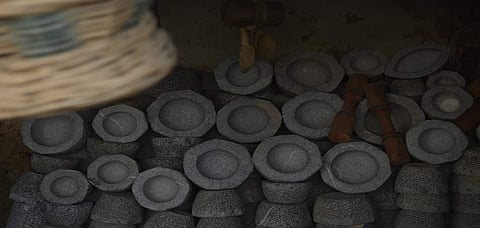- Destinations
- Experiences
- Stay
- What's new
- Celebrating People
- Responsible Tourism
- CampaignsCampaigns
- SubscribeSubscribe
- Buy Now

Humans are a strong and resilient species, with the will to break the hardest of stones and carve them into different shapes with a few simple tools.
I am from Kashmir, the picturesque Himalayan valley where there is a lot more to see than mountains and valleys, meadows and rivers and lakes, and ancient gardens. There are the people, their cultures, for instance.
Kashmiris have a special affinity for stones. We build our homes on plinths made of stones, our gardens are decorated with fountains made out of stone, and we bury our dead and remember them by carving their names on tombstones. While stones surround us so intimately, through my pictures, I have tried to document (to a small extent) the lives and routines of the people who work with them all day.
These pictures capture both the work and life of the stone carvers, and also focus on the different types of carving work that they do in their small workshops that many of us pass each day, listening to the cling-clang of the mallets hitting the chisels, but never thinking of the pain and sweat that's behind that sound.
Set up on the roadside at a place called Sempora, Pampore, along the highway that connects Srinagar, there are workshops where stonemasons can be seen working on stones, creating amazing artifacts with their hard work. These people are sawyers and carvers too. They are master masons.
These stone carvers are called Sang Taraash in Kashmiri, and they are a dying breed.
Stone carving has been an important part of life in Kashmir, whether it is the veneering technique used in building Kashmiri homes, the curbstones used in pathways or the use of stones in gardens, fountains or other such special structures.
"The young generation won't work with stones any more, this is a job that requires patience and diligence," says Ghulam Ahmed Mir. "Young people are short on both these days. He worked as an apprentice with a stone carver for four years before starting work on his own.
"My father, God rest his soul, brought me here. Those days fathers made men out of their sons. Now I see mobile phones and motorbikes and boys. No men."
Carving tools for the craft include mallet, chisel and a metal straight edge (for making flat surfaces). The chisels are of various types depending upon their use. They all need to be sharp, though. In Sempora, different types of stones are carved—Kene Kaen, veneering stones, are produced in bulk. These are used in veneers and plinths. Braande Kaen, or curbstones, are also produced in large numbers. Kaanas, a specially designed stone that is used in fountains and other special structures, and millstones are also made on order.
Ali Mohammad is a master at carving kaanas. He has taken a loan from a bank to get his son admitted in an engineering college. "He didn't want to do this. So I thought he should become an engineer. I would carve stones and he would use them in the structures he builds," he says, with a spark in his eyes.
The Sang Taraash Association, a union of sorts of the stone carvers has been demanding a dispensary to be set up near the workshop. The work is dangerous and injuries, though not common, are possible. The government seems least interested. Although the sales are going down, stone still is a very important part of our lives, and the Sang Taraash is the master of the stone.
